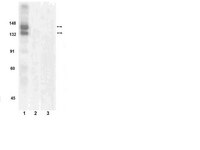Artificial human Met agonists based on macrocycle scaffolds.
Ito, K; Sakai, K; Suzuki, Y; Ozawa, N; Hatta, T; Natsume, T; Matsumoto, K; Suga, H
Nature communications
6
6373
2015
概要を表示する
Hepatocyte growth factor (HGF) receptor, also known as Met, is a member of the receptor tyrosine kinase family. The Met-HGF interaction regulates various signalling pathways involving downstream kinases, such as Akt and Erk. Met activation is implicated in wound healing of tissues via multiple biological responses triggered by the above-mentioned signalling cascade. Here we report the development of artificial Met-activating dimeric macrocycles. We identify Met-binding monomeric macrocyclic peptides by means of the RaPID (random non-standard peptide integrated discovery) system, and dimerize the respective monomers through rational design. These dimeric macrocycles specifically and strongly activate Met signalling pathways through receptor dimerization and induce various HGF-like cellular responses, such as branching morphogenesis, in human cells. This work suggests our approach for generating dimeric macrocycles as non-protein ligands for cell surface receptors can be useful for developing potential therapeutics with a broad range of potential applications. | 25758345
 |
Hepatocyte growth factor receptor tyrosine kinase met is a substrate of the receptor protein-tyrosine phosphatase DEP-1.
Palka, Helena L, et al.
J. Biol. Chem., 278: 5728-35 (2003)
2003
概要を表示する
The receptor protein-tyrosine phosphatase (PTP) DEP-1 (CD148/PTP-eta) has been implicated in the regulation of cell growth, differentiation, and transformation, and most recently has been identified as a potential tumor suppressor gene mutated in colon, lung, and breast cancers. We have generated constructs comprising the cytoplasmic segment of DEP-1 fused to the maltose-binding protein to identify potential substrates and thereby suggest a physiological function for DEP-1. We have shown that the substrate-trapping mutant form of DEP-1 interacted with a small subset of tyrosine-phosphorylated proteins from lysates of the human breast tumor cell lines MDA-MB-231, T-47D, and T-47D/Met and have identified the hepatocyte growth factor/scatter factor receptor Met, the adapter protein Gab1, and the junctional component p120 catenin as potential substrates. Following ligand stimulation, phosphorylation of specific tyrosyl residues in Met induces mitogenic, motogenic, and morphogenic responses. When co-expressed in 293 cells, the full-length substrate-trapping mutant form of DEP-1 formed a stable complex with the chimeric receptor colony stimulating factor 1 (CSF)-Met and wild type DEP-1 dephosphorylated CSF-Met. Furthermore, we observed that DEP-1 preferentially dephosphorylated a Gab1 binding site (Tyr(1349)) and a COOH-terminal tyrosine implicated in morphogenesis (Tyr(1365)), whereas tyrosine residues in the activation loop of Met (Tyr(1230), Tyr(1234), and Tyr(1235)) were not preferred targets of the PTP. The ability of DEP-1 preferentially to dephosphorylate particular tyrosine residues that are required for Met-induced signaling suggests that DEP-1 may function in controlling the specificity of signals induced by this PTK, rather than as a simple "off-switch" to counteract PTK activity. | 12475979
 |










